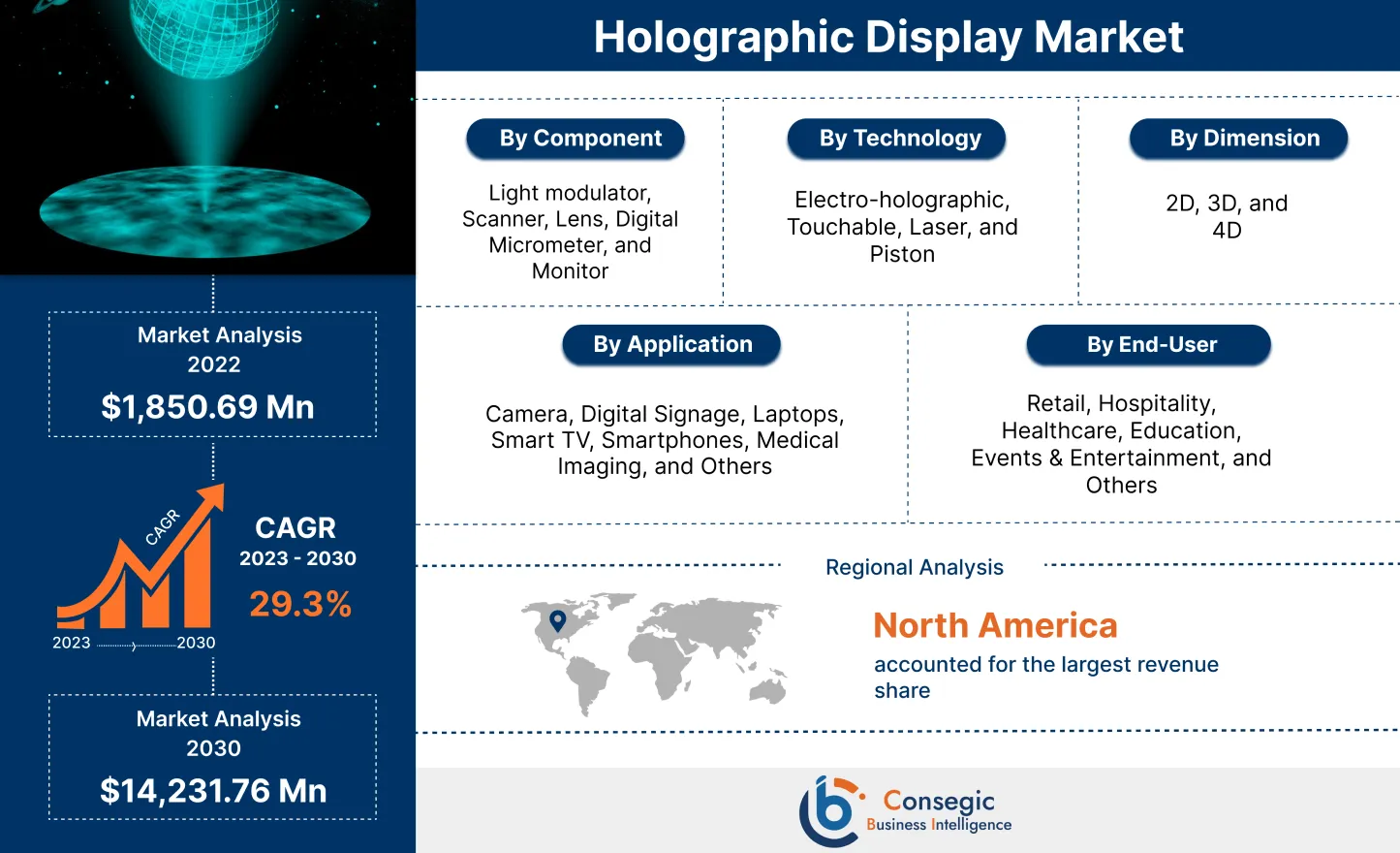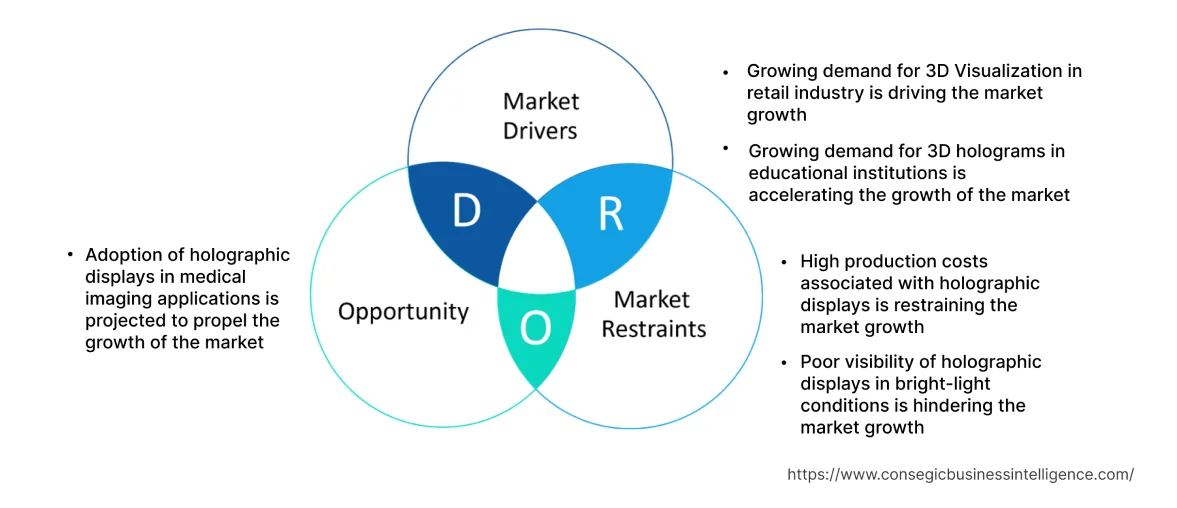Holographic Display Market Size :
Holographic Display Market size is estimated to reach over USD 14,231.76 Million by 2030 from a value of USD 1,850.69 Million in 2022, growing at a CAGR of 29.3% from 2023 to 2030.
Holographic Display Market Scope & Overview:
A holographic display is a technology that projects three-dimensional images or videos to create the illusion of 3D objects in volumetric space. Holograms are generated by interfering beams of light that reflect real and physical objects. They are a potent instrument for attracting people during presentations, fairs, and exhibitions. As a result, as per the analysis, the display allow viewers to see virtual objects or scenes from multiple angles, thereby providing a more immersive experience to the customers.
Holographic Display Market Insights :
Key Drivers :
Growing demand for 3D Visualization in retail industry is driving the holographic display market growth
The increasing demand for holographic display in retail industry to provide realistic 3D visualization of objects and products is accelerating the trend of holographic display market. As per the analysis, holograms are widely used in shopping malls, exhibition spaces, fairs, and shops to provide unique experience and better understanding to the customers. For instance, in February 2022, Accenture made an investment in Looking Glass 65 that allows brands, designers, and consumers to showcase 3D content of the products. Consequently, the adoption of these display's for experiential marketing is driving the market expansion.
Growing demand for 3D holograms in educational institutions is accelerating the growth of the market
The increasing demand for these display in the education sector for visualization of abstract concepts is driving the expansion of the market. Holograms help students to understand complex processes and concepts by viewing realistic and interactive 3D representations. Moreover, holograms are used to facilitate efficient communication between learners and educators by simulating face-to-face interactions. Furthermore, the ability of this display to support hybrid learning models is accelerating the trend of the market. For instance, in September 2020, The University of Texas collaborated with Contextual Content Group to develop a 3D immersive video solution in order to support physical, hybrid and online mode of teaching in colleges and universities. Thus, the application of this display to deliver an engaging and interactive distanced learning experience to the learners is proliferating the expansion of the market.
Key Restraints :
High production costs is restraining the holographic display market expansion
Holographic display technologies are more expensive compared to traditional display technologies. Expensive materials and complicated fabrication procedures required for the production of holograms are the major factors contributing to the high prices of this display. Thus, based on the analysis, the high cost of computer-generated holographic techniques in the generation of 2D to 3D images is hindering the trend of the market. Moreover, the high implementation and maintenance costs of holograms in industries are further limiting the expansion of the market.
Poor visibility of holographic display in bright-light conditions is hindering the holographic display market expansion
Holographic display work by reflecting light-off the surface to create a 3-D image. However, bright light or direct sunlight interferes with the reflection of holographic images, thereby resulting in less visibility of holograms. Therefore, the inability of this display to function in bright light conditions is hindering the development of the market. Moreover, hologram display are not clearly visible during fluorescent lighting conditions, further limiting the development of the market.
Future Opportunities :
Adoption in medical imaging applications is projected to propel the growth of the holographic display market
The adoption of holographic display in medical imaging applications including MRI and CT scan is expected to present potential opportunities for the expansion of the market. As per the analysis, these display provide radiologists with enhanced 3D visualization of MRI and CT scan data. As a result, holograms allow for a better understanding of the anatomical structures and abnormalities, thus enabling more accurate diagnosis and treatment planning. Furthermore, any advancements in the technology for 3D visualization of MRI and CT scan will create trends and holographic display market opportunity to grow during the forecast period.
Holographic Display Market Report Insights :
| Report Attributes | Report Details |
| Study Timeline | 2017-2030 |
| Market Size in 2030 | USD 14,231.76 Million |
| CAGR (2023-2030) | 29.3% |
| By Component | Light modulator, Scanner, Lens, Digital Micrometer, and Monitor |
| By Technology | Electro-holographic, Touchable, Laser, and Piston |
| By Dimension | 2D, 3D, and 4D |
| By Application | Camera, Digital Signage, Laptops, Smart TV, Smartphones, Medical Imaging, and Others |
| By End-User | Retail, Hospitality, Healthcare, Education, Events & Entertainment, and Others |
| By Region | North America, Europe, Asia-Pacific, Latin America, and Middle East & Africa |
| Key Players | AV Concepts Inc., HoloTech Switzerland AG, Holoxica Limited, HYPERVSN, Leia Display System, MDH Hologram, Qualcomm Incorporated, Realfiction, RealView Imaging Ltd., ViewSonic Corporation |
Holographic Display Market Segmental Analysis :
By Component :
Based on the component, the market is segregated into light modulator, scanner, lens, digital micrometer, and monitor. The light modulator segment accounted for the largest revenue share in the year 2022. Spatial Light Modulator modulators (SLMs) are electro-optical devices that manipulate fundamental characteristics such as phase, amplitude, and polarization state of light. Therefore, SLM plays a crucial role in this type of display to eliminate undesired artifacts such as low resolution and noise. For instance, in April 2022, Hamamatsu Photonics developed a new spatial light modulator (SLM) to improve the efficiency and accuracy of laser techniques.
The lens segment is expected to register the fastest CAGR during the forecast period. Holographic lenses play a crucial role in manipulating the light source to adequately illuminate the object from more than one direction while also illuminating the photographic plate. Therefore, based on the analysis, holographic lenses are strategically placed on the photographic plate at different angles to provide clear 3D representation of images. Furthermore, the ability of holographic lenses to illuminate the space around the object in order to create 3D imaging is expected to drive market expansion during the forecast period.
By Technology :
Based on the technology, the market is segregated into electro-holographic, touchable, laser, and piston. The electro-holographic segment accounted for the largest revenue share in the year 2022. They employ spatial light modulators (SLMs) or liquid crystal display (LCDs) to manipulate light waves and create the interference patterns necessary for hologram formation. Moreover, electro-holographic display offer high resolution and provide realistic 3D visualizations. In conclusion, the application of electro-optical modulation techniques to generate holographic images is accelerating the expansion of the market.
Laser-based display is expected to witness fastest CAGR during the forecast period. Laser-based display use laser beams to record and project holographic images. Based on the analysis, the display that use laser light as the source exhibit high spatial resolution and sharpness, thereby capturing fine details of the displayed objects. Therefore, laser-based holograms produce high-quality, high-resolution holographic images and are used in various industries, including entertainment, advertising, and product visualization.
By Dimension :
Based on the dimensions, the market is trifurcated into 2D, 3D, and 4D. 3D segment accounted for the largest revenue share of 46.09% in the year 2022. 3D holograms create realistic holographic images or videos that are viewed from multiple angles, allowing users to perceive depth and spatial relationships. 3D holograms are well-suited for applications such as gaming, entertainment, medical imaging, design visualization, and virtual reality. For instance, in July 2022, Looking Glass launched the world's largest 3D display called the Looking Glass 65 featuring light field technology to produce an immersive experience. Consequently, 3D display offer an immersive and interactive visual experience by simulating depth, resulting in market expansion.
4D segment is expected to register the fastest CAGR during the forecast period. 4D holograms create dynamic holographic experiences by adding motion and temporal effects to the holographic content. As per the analysis, the fourth dimension is introduced through techniques such as animation, particle effects, or dynamic hologram projections. Thus, the ability of 4D holograms to produce real-time content is accelerating the trend of the market.
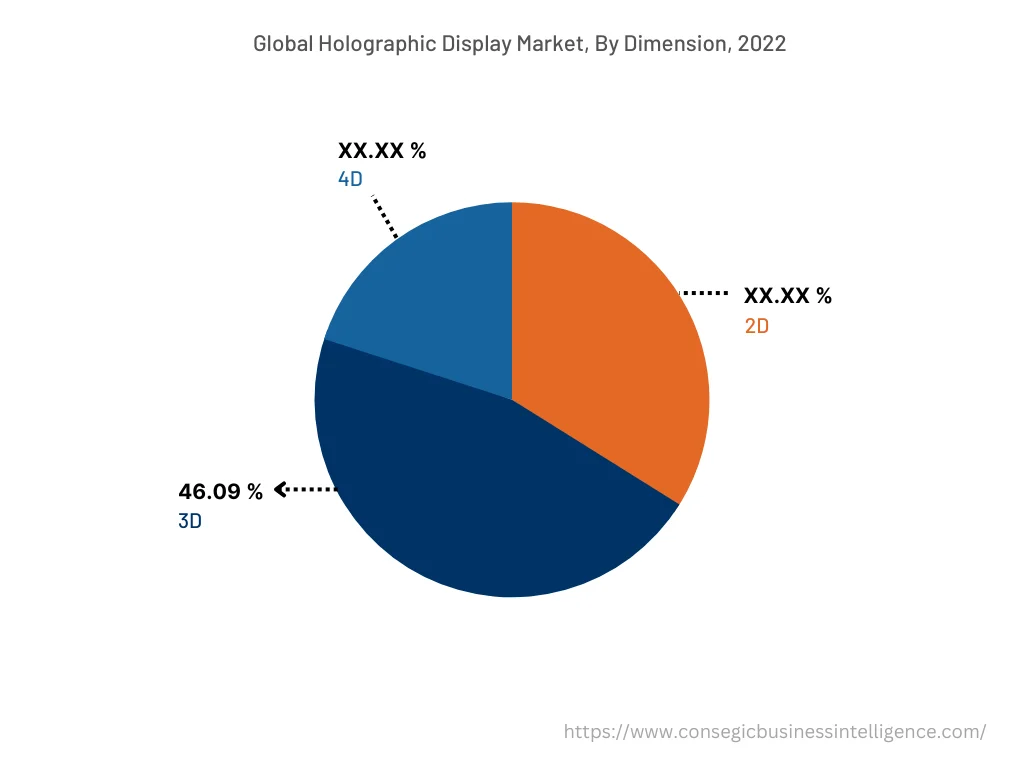
By Application :
Based on the application, the market is divided into camera, digital signage, laptops, smart TV, smartphones, medical imaging, and others. Smart TV segment accounted for the largest revenue share in the year 2022. The advancements in technology of TVs such as the development of high-definition (HD) display is driving the expansion of the market. Manufacturers are increasingly producing televisions that display 3D projection of an object onto a 2D plane. 3D images are created by recording the interference pattern between two laser beams on a holographic film or plate. Therefore, as per the analysis, the display play a crucial role in providing high-quality content, resulting in market trends.
The smartphone segment is anticipated to emerge as the fastest-growing segment during the forecast period. The display create 3D images allowing objects to appear or float in air space. The sensor used in smartphones detects the polarization of light to create 3D images of objects in order to provide an immersive experience to the users. Additionally, holograms provide a wider view-angle and a natural depth perception in comparison to the traditional flat display. For instance, in March 2021, Massachusetts Institute of Technology generated 3D holograms in real-time for smartphones in virtual reality, and 3D printing applications.
By End-User :
Based on the end-user, the market is divided into retail, hospitality, healthcare, education, events & entertainment, and others. The retail sector accounted for the largest revenue share in the year 2022. Holograms offer innovative and attention-grabbing visual experiences in the retail sector. The display are used to create high-quality display, virtual try-on solutions, and interactive advertisements in order to attract a large number of customers towards this segment. As a result, the display increase brand awareness and engage a large number of customers, leading to the development of the regional market.
Events & Entertainment sector is expected to witness fastest CAGR during the forecast period. The increasing adoption of AR/VR applications in events & entertainment sector to provide an interactive and engaging experience to the viewers is driving the development of the market. The display are used in gaming applications to allow viewers to observe objects in 3D representations. Moreover, the application of holograms in events and concerts to provide a real-time experience to the viewers is further accelerating the trend of the market.
By Region :
The regional segment includes North America, Europe, Asia Pacific, Middle East and Africa, and Latin America.
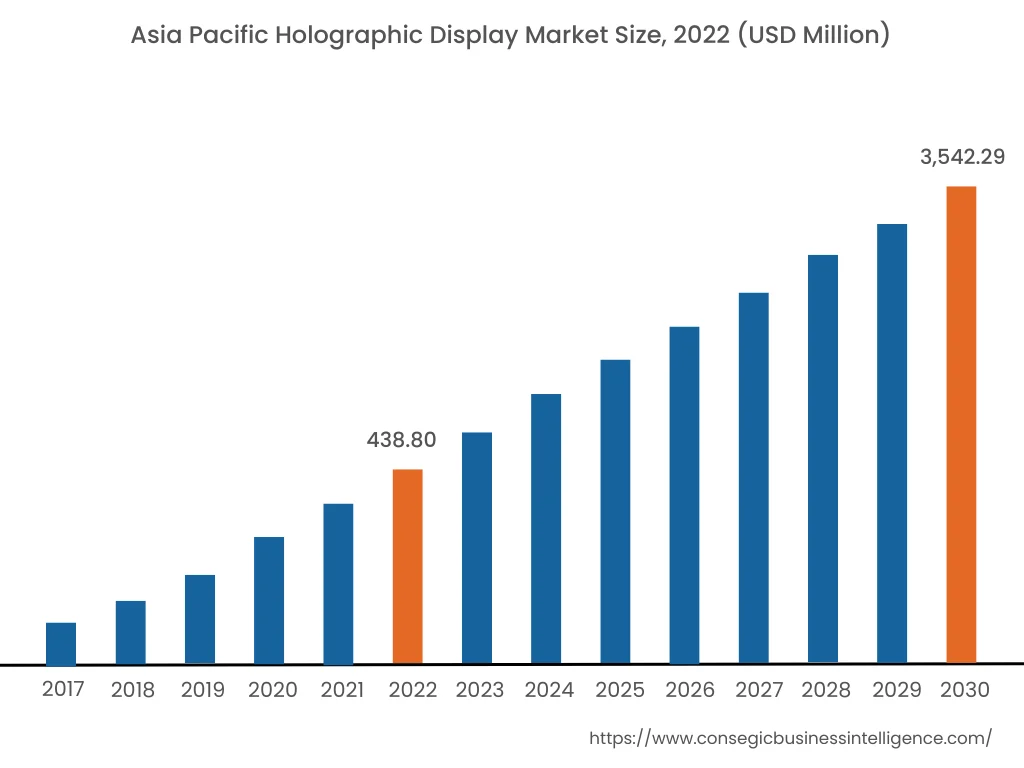
North America accounted for the largest revenue share in the year 2022. The growing adoption of consumer electronics such as smartphones, tablets, and other personal electronic devices is driving the holographic display market growth. Based on the holographic display market analysis, manufacturers are increasingly incorporating these display capabilities into the devices to enhance user experiences and offer more immersive content. Moreover, the adoption of advanced technologies such as Augmented Reality (AR) and Virtual Reality (VR) applications in the region is driving the holographic display market trend. They are widely used in gaming applications to improve users' experience. For instance, according to Oberlo, 70.8 million people in the US are using VR technology in 2023. Thus, the growing adoption of the aforementioned technologies is driving the growth of the regional market.
The Asia-Pacific region accounted for a revenue share of USD 438.80 Million in 2022 and is expected to reach USD 3542.29 Million in 2030, registering a CAGR of 30.1% during the forecast period. Additionally, in the region, China accounted for the largest holographic display market share of 29.9% in the year 2022. The increasing adoption in retail sector for marketing and customer engagement is driving the holographic display market demand. The display offer unique visual content in order to grab the attention of a large number of customers. Furthermore, the growth of media & entertainment sector in Asia-Pacific region is further expected to propel the growth of the regional market.
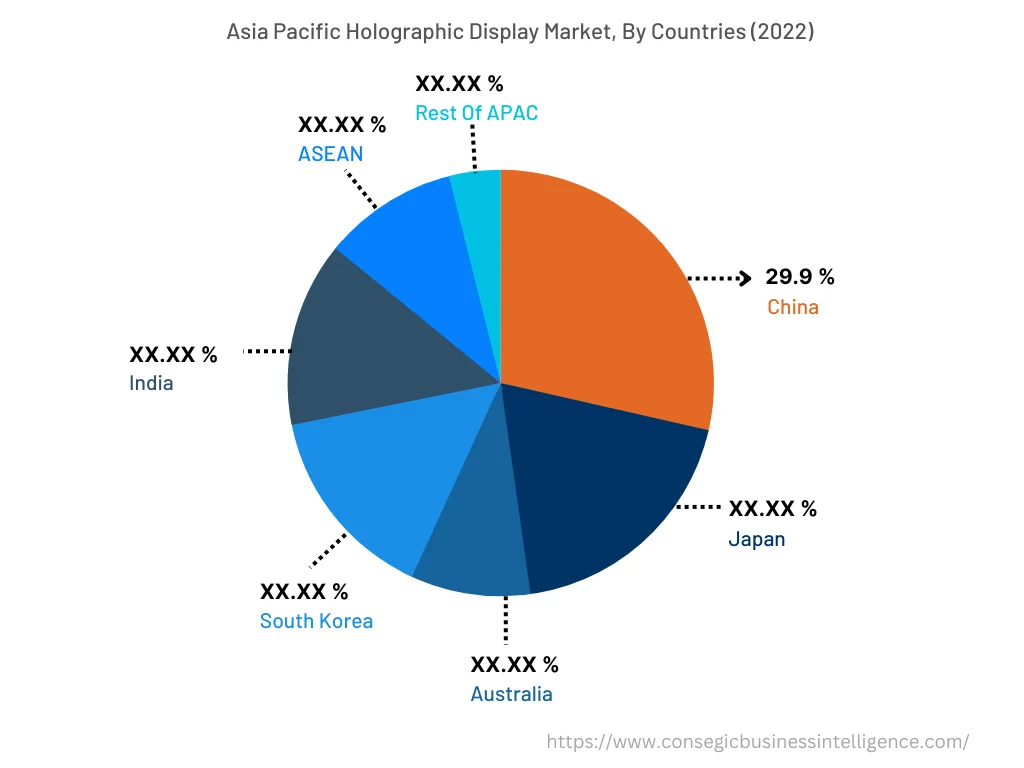
Competitive Landscape :
The global holographic market is characterized by the presence of major players providing interactive and immersive display solutions. Key players are adopting several strategies in research and development, product innovation, and various business strategies, and application launches have accelerated the growth of the market. Key players in the holographic display industry include-
- AV Concepts Inc.
- HoloTech Switzerland AG
- Holoxica Limited
- HYPERVSN
- Leia Display System
- MDH Hologram
- Qualcomm Incorporated
- Realfiction
- RealView Imaging Ltd.
- ViewSonic Corporation
Recent Industry Developments :
- In October 2021, Cisco Systems Inc. launched an immersive 3D holograms called Webex Hologram in order to support next-generation hybrid work culture.
- In July 2021, Nippon Telegraph and Telephone Corporation announced to launch ultra-realistic communication technology for holographic video of badminton competition at TOKYO 2020.
Key Questions Answered in the Report
What is Holographic Display? +
Holographic display is a technology that creates 3D images of an object or a device in order to provide engaging experience to the users. Holograms use multiple beams of light that reflect real and physical objects.
What specific segmentation details are covered in the holographic display report, and how is the dominating segment impacting the market growth? +
The report consists of segments including component, technology dimension, application and end-user. Each segment has key dominating sub-segment being driven by the industry trends and market dynamics. For instance, by application segment has witnessed smart TV as the dominating segment in the year 2022, due to its ability to make 3D images visible on the 2D plane.
What specific segmentation details are covered in the market report, and how is the fastest segment anticipated to impact the market growth? +
The report consists of segments including component, technology, dimension, application and end-user. Each segment is projected to have the fastest-growing sub-segment being fueled by industry trends and drivers. For instance, by dimension segment has witnessed 4D as the fastest-growing segment during the forecast period due to its ability to ass motion and temporal effects to the holographic content.
Which region/country is anticipated to witness the highest CAGR during the forecast period, 2023-2030? +
Asia-Pacific region is expected to register fastest CAGR growth during the forecast period due to the increasing adoption of holographic content for digital marketing in retail industry.
